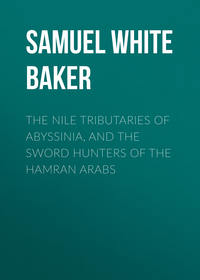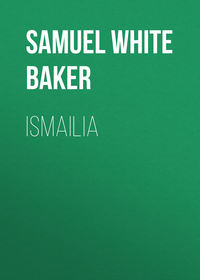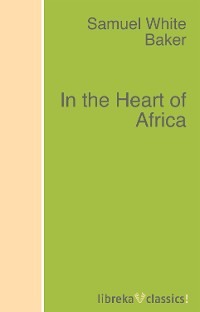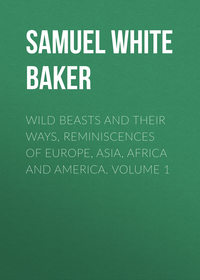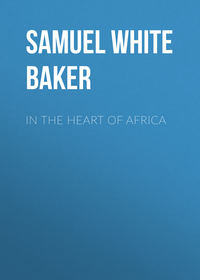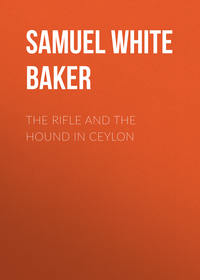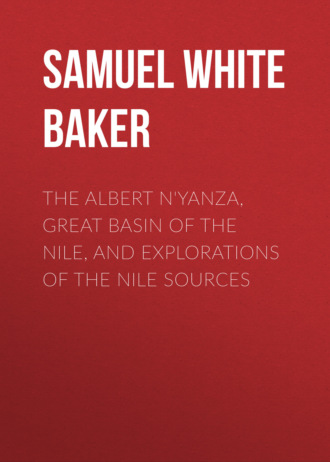 полная версия
полная версияThe Albert N'Yanza, Great Basin of the Nile, And Explorations of the Nile Sources
The average size of the African elephant is larger than those of Ceylon, although I have occasionally shot monster rogues in the latter country, equal to anything that I have seen in Africa. The average height of female elephants in Ceylon is about 7 ft. 10 in. at the shoulder, and that of the males is about 9 ft.; but the usual height of the African variety I have found, by actual measurement, of females to be 9 ft., while that of the bills is 10 ft. 6 in. Thus the females of the African are equal to the males of Ceylon.
They also differ materially in their habits. In Ceylon, the elephant seeks the shade of thick forests at the rising of the sun, in which he rests until about 5 P.M., when he wanders forth upon the plains. In Africa, the country being generally more open, the elephant remains throughout the day either beneath a solitary tree, or exposed to the sun in the vast prairies, where the thick grass attains a height of from nine to twelve feet. The general food of the African elephant consists of the foliage of trees, especially of mimosas. In Ceylon, although there are many trees that serve as food, the elephant nevertheless is an extensive grass-feeder. The African variety, being almost exclusively a tree-feeder, requires his tusks to assist him in procuring food. Many of the mimosas are flat-headed, about thirty feet high, and the richer portion of the foliage confined to the crown; thus the elephant, not being able to reach to so great a height, must overturn the tree to procure the coveted food. The destruction caused by a herd of African elephants in a mimosa forest is extraordinary; and I have seen trees uprooted of so large a size, that I am convinced no single elephant could have overturned them. I have measured trees four feet six inches in circumference, and about thirty feet high, uprooted by elephants. The natives have assured me that they mutually assist each other, and that several engage together in the work of overturning a large tree. None of the mimosas have tap-roots; thus the powerful tusks of the elephants, applied as crowbars at the roots, while others pull at the branches with their trunks, will effect the destruction of a tree so large as to appear invulnerable. The Ceylon elephant rarely possessing tusks, cannot destroy a tree thicker than the thigh of an ordinary man.
In Ceylon, I have seldom met old bulls in parties—they are generally single or remain in pairs; but, in Africa, large herds are met with, consisting entirely of bulls. I have frequently seen sixteen or twenty splendid bulls together, presenting a show of ivory most exciting to a hunter. The females in Africa congregate in vast herds of many hundreds, while in Ceylon the herds seldom average more than ten.
The elephant is by far the most formidable of all animals, and the African variety is more dangerous than the Indian, as it is next to impossible to kill it by the forehead shot. The head is so peculiarly formed, that the ball either passes over the brain, or lodges in the immensely solid bones and cartilages that contain the roots of the tusks. I have measured certainly a hundred bull tusks, and I have found them buried in the head a depth of 24 inches. One large tusk, that measured 7 ft. 8 in. in length, and 22 inches in girth, was imbedded in the head a depth of 31 inches. This will convey an idea of the enormous size of the head, and of the strength of bone and cartilage required to hold in position so great a weight, and to resist the strain when the tusk is used as a lever to uproot trees.
The brain of an African elephant rests upon a plate of bone exactly above the roots of the upper grinders; it is thus wonderfully protected from a front shot, as it lies so low that the ball passes above it when the elephant raises his head, which he invariably does when in anger, until close to the object of his attack.
The character of the country naturally influences the habits of the animals: thus, Africa being more generally open than the forest-clad Ceylon, the elephant is more accustomed to activity, and is much faster than the Ceylon variety. Being an old elephant-hunter of the latter island, I was exceedingly interested in the question of variety of species, and I had always held the opinion that the African elephant might be killed with the same facility as that of Ceylon, by the forehead shot, provided that a sufficient charge of powder were used to penetrate the extra thickness of the head. I have found, by much experience, that I was entirely wrong, and that, although by CHANCE an African elephant may be killed by the front shot, it is the exception to the rule. The danger of the sport is, accordingly, much increased, as it is next to impossible to kill the elephant when in full charge, and the only hope of safety consists in turning him by a continuous fire with heavy guns: this cannot always be effected.
I had a powerful pair of No. 10 polygroove rifles, made by Reilly of Oxford Street; they weighed fifteen pounds, and carried seven drachms of powder without a disagreeable recoil. The bullet was a blunt cone, one and a half diameter of the bore, and I used a mixture of nine-tenths lead and one-tenth quicksilver for the hardening of the projectile. This is superior to all mixtures for that purpose, as it combines hardness with extra weight; the lead must be melted in a pot by itself to a red heat, and the proportion of quicksilver must be added a ladle-full at a time, and stirred quickly with a piece of iron just in sufficient quantity to make three or four bullets. If the quicksilver is subjected to a red heat in the large lead-pot, it will evaporate. The only successful forehead shot that I made at an African elephant was shortly after my arrival in the Abyssinian territory on the Settite river; this was in thick thorny jungle, and an elephant from the herd charged with such good intention, that had she not been stopped, she must have caught one of the party. When within about five yards of the muzzle, I killed her dead by a forehead shot with a hardened bullet as described, from a Reilly No. 10 rifle, and we subsequently recovered the bullet in the VERTEBRAE OF THE NECK!
This extraordinary penetration led me to suppose that I should always succeed as I had done in Ceylon, and I have frequently stood the charge of an African elephant until close upon me, determined to give the forehead shot a fair trial, but I have ALWAYS failed, except in the instance now mentioned; it must also be borne in mind that the elephant was a female, with a head far inferior in size and solidity to that of the male.
The temple shot, and that behind the ear, are equally fatal in Africa as in Ceylon, provided the hunter can approach within ten or twelve yards; but altogether the hunting is far more difficult, as the character of the country does not admit of an approach sufficiently close to guarantee a successful shot. In the forests of Ceylon an elephant can be stalked to within a few paces, and the shot is seldom fired at a greater distance than ten yards: thus accuracy of aim is insured; but in the open ground of Africa, an elephant can seldom be approached within fifty yards, and should he charge the hunter, escape is most difficult. I never found African elephants in good jungle, except once, and on that occasion I shot five, quite as quickly as we should kill them in Ceylon.
The character of the sport must vary according to the character of the country; thus there may be parts of Africa at variance with my description. I only relate my own experience.
Among other weapons, I had an extraordinary rifle that carried a half-pound percussion shell—this instrument of torture to the hunter was not sufficiently heavy for the weight of the projectile; it only weighed twenty pounds: thus, with a charge of ten drachms of powder, behind a HALF-POUND shell, the recoil was so terrific, that I was spun round like a weathercock in a hurricane. I really dreaded my own rifle, although I had been accustomed to heavy charges of powder and severe recoil for many years.
None of my men could fire it, and it was looked upon with a species of awe, and was named "Jenna el Mootfah" (child of a cannon) by the Arabs, which being far too long a name for practice, I christened it the "Baby;" and the scream of this "Baby," loaded with a half-pound shell, was always fatal. It was far too severe, and I very seldom fired it, but it is a curious fact, that I never fired a shot with that rifle without bagging: the entire practice, during several years, was confined to about twenty shots. I was afraid to use it; but now and then it was absolutely necessary that it should be cleaned, after lying for months loaded. On such occasions my men had the gratification of firing it, and the explosion was always accompanied by two men falling on their backs (one having propped up the shooter), and the "Baby" flying some yards behind them. This rifle was made by Holland, of Bond Street, and I could highly recommend it for Goliath of Gath, but not for men of A.D. 1866.
The natives of Central Africa generally hunt the elephant for the sake of the flesh, and prior to the commencement of the White Nile trade by the Arabs, and the discovery of the Upper White Nile to the 5 degrees N. lat. by the expedition sent by Mehemet Ali Pasha, the tusks were considered as worthless, and were treated as bones. The death of an elephant is a grand affair for the natives, as it supplies flesh for an enormous number of people, also fat, which is the great desire of all savages for internal and external purposes. There are various methods of killing them. Pitfalls are the most common, but the wary old bulls are seldom caught in this manner.
The position chosen for the pit is, almost without exception, in the vicinity of a drinking place, and the natives exhibit a great amount of cunning in felling trees across the usual run of the elephants, and sometimes cutting an open pit across the path, so as to direct the elephant by such obstacles into the path of snares. The pits are usually about twelve feet long, and three feet broad, by nine deep; these are artfully made, decreasing towards the bottom to the breadth of a foot. The general elephant route to the drinking place being blocked up, the animals are diverted by a treacherous path towards the water, the route intersected by numerous pits, all of which are carefully concealed by sticks and straw, the latter being usually strewn with elephants' dung to create a natural effect.
Should an elephant, during the night, fall through the deceitful surface, his foot becomes jammed in the bottom of the narrow grave, and he labours shoulder deep, with two feet in the pitfall so fixed that extrication is impossible. Should one animal be thus caught, a sudden panic seizes the rest of the herd, and in their hasty retreat one or more are generally victims to the numerous pits in the vicinity. The old bulls never approach a watering place rapidly, but carefully listen for danger, and then slowly advance with their warning trunks stretched to the path before them; the delicate nerves of the proboscis at once detect the hidden snare, and the victims to pitfalls are the members of large herds who, eager to push forward incautiously, put their "foot into it," like shareholders in bubble companies. Once helpless in the pit, they are easily killed with lances.
The great elephant hunting season is in January, when the high prairies are parched and reduced to straw. At such a time, should a large herd of animals be discovered, the natives of the entire district collect together to the number of perhaps a thousand men; surrounding the elephants by embracing a considerable tract of country, they fire the grass at a given signal. In a few minutes the unconscious elephants are surrounded by a circle of fire, which, however distant, must eventually close in upon them. The men advance with the fire, which rages to the height of twenty or thirty feet. At length the elephants, alarmed by the volumes of smoke and the roaring of the flames, mingled with the shouts of the hunters, attempt an escape. They are hemmed in on every side—wherever they rush, they are met by an impassable barrier of flames and smoke, so stifling, that they are forced to retreat. Meanwhile the fatal circle is decreasing; buffaloes and antelopes, likewise doomed to a horrible fate, crowd panic stricken to the centre of the encircled ring, and the raging fire sweeps over all. Burnt and blinded by fire and smoke, the animals are now attacked by the savage crowd of hunters, excited by the helplessness of the unfortunate elephants thus miserably sacrificed, and they fall under countless spears. This destructive method of hunting ruins the game of that part of Africa, and so scarce are the antelopes, that, in a day's journey, a dozen head are seldom seen in the open prairie.
The next method of hunting is perfectly legitimate. Should many elephants be in the neighbourhood, the natives post about a hundred men in as many large trees; these men are armed with heavy lances specially adapted to the sport, with blades about eighteen inches long and three inches broad. The elephants are driven by a great number of men towards the trees in which the spearmen are posted, and those that pass sufficiently near are speared between the shoulders. The spear being driven deep into the animal, creates a frightful wound, as the tough handle, striking against the intervening branches of trees, acts as a lever, and works the long blade of the spear within the elephant, cutting to such an extent that he soon drops from exhaustion.
The best and only really great elephant-hunters of the White Nile are the Bagara Arabs, on about the 13 degree N. lat. These men hunt on horseback, and kill the elephant in fair fight with their spears.
The lance is about fourteen feet long, of male bamboo; the blade is about fourteen inches long by nearly three inches broad; this is as sharp as a razor. Two men, thus armed and mounted, form the hunting party. Should they discover a herd, they ride up to the finest tusker and single him from the others. One man now leads the way, and the elephant, finding himself pressed, immediately charges the horse. There is much art required in leading the elephant, who follows the horse with great determination, and the rider adapts his pace so as to keep his horse so near the elephant that his attention is entirely absorbed with the hope of catching him. The other hunter should by this tine have followed close to the elephant's heels, and, dismounting when at full gallop with wonderful dexterity, he plunges his spear with both hands into the elephant about two feet below the junction of the tail, and with all his force he drives the spear about eight feet into his abdomen, and withdraws it immediately. Should he be successful in his stab, he remounts his horse and flies, or does his best to escape on foot, should he not have time to mount, as the elephant generally turns to pursue him. His comrade immediately turns his horse, and, dashing at the elephant, in his turn dismounts, and drives his lance deep into his intestines.
Generally, if the first thrust is scientifically given, the bowels protrude to such an extent that the elephant is at once disabled. Two good hunters will frequently kill several out of one herd; but in this dangerous hand-to-hand fight the hunter is often the victim. Hunting the elephant on horseback is certainly far less dangerous than on foot, but although the speed of the horse is undoubtedly superior, the chase generally takes place upon ground so disadvantageous, that he is liable to fall, in which case there is little chance for either animal or rider. So savage are the natural instincts of Africans, that they attend only to the destruction of the elephant, and never attempt its domestication.
CHAPTER VIII
IBRAHIM's RETURN
Ibrahim returned from Gondokoro, bringing with him a large supply of ammunition. A wounded man of Chenooda's people also arrived, the sole relic of the fight with the Latookas; he had been left for dead, but had recovered, and for days and nights he had wandered about the country, in thirst and hunger, hiding like a wild beast from the sight of human beings, his guilty conscience marking every Latooka as an enemy. As a proof of the superiority of the natives to the Khartoumers, he had at length been met by some Latookas, and not only was well treated and fed by their women, but they had guided him to Ibrahim's camp.
The black man is a curious anomaly, the good and bad points of human nature bursting forth without any arrangement, like the flowers and thorns of his own wilderness. A creature of impulse, seldom actuated by reflection, the black man astounds by his complete obtuseness, and as suddenly confounds you by an unexpected exhibition of sympathy. From a long experience with African savages, I think it is as absurd to condemn the negro in toto, as it is preposterous to compare his intellectual capacity with that of the white man. It is unfortunately the fashion for one party to uphold the negro as a superior being, while the other denies him the common powers of reason. So great a difference of opinion has ever existed upon the intrinsic value of the negro, that the very perplexity of the question is a proof that he is altogether a distinct variety. So long as it is generally considered that the negro and the white man are to be governed by the same laws and guided by the same management, so long will the former remain a thorn in the side of every community to which he may unhappily belong. When the horse and the ass shall be found to match in double harness, the white man and the African black will pull together under the same regime. It is the grand error of equalizing that which is unequal, that has lowered the negro character, and made the black man a reproach.
In his savage home, what is the African? Certainly bad; but not so bad as white men would (I believe) be under similar circumstances. He is acted upon by the bad passions inherent in human nature, but there is no exaggerated vice, such as is found in civilized countries. The strong takes from the weak, one tribe fights the other—do not perhaps we in Europe?—these are the legitimate acts of independent tribes, authorized by their chiefs. They mutually enslave each other—how long is it since America and WE OURSELVES ceased to be slaveholders? He is callous and ungrateful—in Europe is there no ingratitude?
He is cunning and a liar by nature—in Europe is all truth and sincerity? Why should the black man not be equal to the white? He is as powerful in frame, a why should he not be as exalted in mind?
In childhood I believe the negro to be in advance, in intellectual quickness, of the white child of a similar age, but the mind does not expand—it promises fruit, but does not ripen; and the negro man has grown in body, but not advanced in intellect.
The puppy of three months old is superior in intellect to a child of the same age, but the mind of the child expands, while that of the dog has arrived at its limit. The chicken of the common fowl has sufficient power and instinct to run in search of food the moment that it leaves the egg, while the young of the eagle lies helpless in its nest; but the young eagle outstrips the chicken in the course of time. The earth presents a wonderful example of variety in all classes of the human race, the animal and vegetable kingdoms. People, beasts, and plants belonging to distinct classes, exhibit special qualities and peculiarities. The existence of many hundred varieties of dogs cannot interfere with the fact that they belong to one genus: the greyhound, pug, bloodhound, pointer, poodle, mastiff, and toy terrier, are all as entirely different in their peculiar instincts as are the varieties of the human race. The different fruits and flowers continue the example;—the wild grapes of the forest are grapes, but although they belong to the same class, they are distinct from the luscious "Muscatel;" and the wild dog-rose of the hedge, although of the same class, is inferior to the moss-rose of the garden.
From fruits and flowers we may turn to insect life, and, watch the air teeming with varieties of the same species, the thousands of butterflies and beetles, the many members of each class varying in instincts and peculiarities. Fishes, and even shellfish, all exhibit the same arrangement,—that every group is divided into varieties all differing from each other, and each distinguished by some peculiar excellence or defect.
In the great system of creation that divided races and subdivided them according to mysterious laws, apportioning special qualities to each, the varieties of the human race exhibit certain characters and qualifications which adapt them for specific localities. The natural character of those races will not alter with a change of locality, but the instincts of each race will be developed in any country where they may be located. Thus, the English are as English in Australia, India, and America, as they are in England, and in every locality they exhibit the industry and energy of their native land; even so the African will remain negro in all his natural instincts, although transplanted to other soils; and those natural instincts being a love of idleness and savagedom, he will assuredly relapse into an idle and savage state, unless specially governed and forced to industry.
The history of the negro has proved the correctness of this theory. In no instance has he evinced other than a retrogression, when once freed from restraint. Like a horse without harness, he runs wild, but, if harnessed, no animal is more useful. Unfortunately, this is contrary to public opinion in England, where the vox populi assumes the right of dictation upon matters and men in which it has had no experience. The English insist upon their own weights and measures as the scales for human excellence, and it has been decreed by the multitude, inexperienced in the negro personally, that he has been a badly-treated brother; that he is a worthy member of the human family, placed in an inferior position through the prejudice and ignorance of the white man, with whom he should be upon equality.
The negro has been, and still is, thoroughly misunderstood. However severely we may condemn the horrible system of slavery, the results of emancipation have proved that the negro does not appreciate the blessings of freedom, nor does he show the slightest feeling of gratitude to the hand that broke the rivets of his fetters. His narrow mind cannot embrace that feeling of pure philanthropy that first prompted England to declare herself against slavery, and he only regards the antislavery movement as a proof of his own importance. In his limited horizon he is himself the important object, and, as a sequence to his self-conceit, he imagines that the whole world is at issue concerning the black man. The negro, therefore, being the important question, must be an important person, and he conducts himself accordingly—he is far too great a man to work. Upon this point his natural character exhibits itself most determinedly. Accordingly, he resists any attempt at coercion; being free, his first impulse is to claim an equality with those whom he lately served, and to usurp a dignity with absurd pretensions, that must inevitably insure the disgust of the white community. Ill-will thus engendered, a hatred and jealousy is established between the two races, combined with the errors that in such conditions must arise upon both sides. The final question remains, Why was the negro first introduced into our colonies—and to America?
The SUN is the great arbitrator between the white and the black man. There are productions necessary to civilized countries, that can alone be cultivated in tropical climates, where the white man cannot live if exposed to labour in the sun. Thus, such fertile countries as the West Indies and portions of America being without a native population, the negro was originally imported as a slave to fulfil the conditions of a labourer. In his own country he was a wild savage, and enslaved his brother man; he thus became a victim to his own system; to the institution of slavery that is indigenous to the soil of Africa, and that has NOT BEEN TAUGHT TO THE AFRICAN BY THE WHITE MAN, as is currently reported, but that has ever been the peculiar characteristic of African tribes.
In his state of slavery the negro was compelled to work, and, through his labour, every country prospered where he had been introduced. He was suddenly freed; and from that moment he refused to work, and instead of being a useful member of society, he not only became a useless burden to the community, but a plotter and intriguer, imbued with a deadly hatred to the white man who had generously declared him free.




